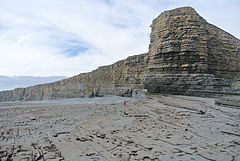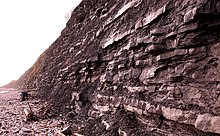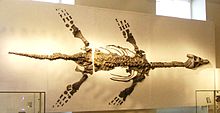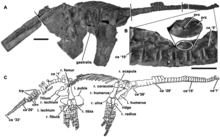
Plesiosaurus is a genus of extinct, large marine sauropterygian reptile that lived during the Early Jurassic. It is known by nearly complete skeletons from the Lias of England. It is distinguishable by its small head, long and slender neck, broad turtle-like body, a short tail, and two pairs of large, elongated paddles. It lends its name to the order Plesiosauria, of which it is an early, but fairly typical member. It contains only one species, the type, Plesiosaurus dolichodeirus. Other species once assigned to this genus, including P. brachypterygius, P. guilielmiimperatoris, and P. tournemirensis have been reassigned to new genera, such as Hydrorion, Seeleyosaurus and Occitanosaurus.
The Early Jurassic Epoch is the earliest of three epochs of the Jurassic Period. The Early Jurassic starts immediately after the Triassic–Jurassic extinction event, 201.3 Ma, and ends at the start of the Middle Jurassic 174.7 ±0.8 Ma.
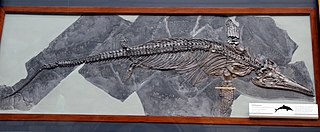
Ichthyosaurus is a genus of ichthyosaurs from the Early Jurassic, with possible Late Triassic record, from Europe. It is among the best known ichthyosaur genera, as it is the type genus of the order Ichthyosauria.

The Polden Hills in Somerset, England are a long, low ridge, extending for 10 miles (16 km), and separated from the Mendip Hills, to which they are nearly parallel, by a marshy tract, known as the Somerset Levels. They are now bisected at their western end by the M5 motorway and a railway, the Bristol and Exeter Railway, part of the Great Western Main Line.
The Hettangian is the earliest age and lowest stage of the Jurassic Period of the geologic timescale. It spans the time between 201.3 ± 0.2 Ma and 199.3 ± 0.3 Ma. The Hettangian follows the Rhaetian and is followed by the Sinemurian.

Temnodontosaurus is an extinct genus of ichthyosaur from the Early Jurassic period. They lived between 200 and 175 million years ago (Hettangian-Toarcian) in what is now Western Europe and possibly Chile. It lived in the deeper areas of the open ocean. University of Bristol paleontologist Jeremy Martin described the genus Temnodontosaurus as "one of the most ecologically disparate genera of ichthyosaurs," although the number of valid Temnodontosaurus species has varied over the years.

Sarcosaurus is a genus of basal neotheropod dinosaur, roughly 3.5 metres (11 ft) long. It lived in what is now England and maybe Ireland and Scotland during the Hettangian-Sinemurian stages of the Early Jurassic, about 199-196 million years ago. Sarcosaurus is one of the earliest known Jurassic theropods, and one of only a handful of theropod genera from this time period. Along with Dracoraptor hanigani it is one of the two described neotheropods from the lowermost Jurassic of the United Kingdom.

Blue Anchor to Lilstock Coast SSSI is a 742.8 hectare geological Site of Special Scientific Interest between Blue Anchor and Lilstock in Somerset, notified in 1971.

Excalibosaurus is a monotypic genus of marine prehistoric reptiles (ichthyosaurs) that lived during the Sinemurian stage of the Early Jurassic period in what is now England. It is characterized by the extreme elongation of the rostrum, with the lower jaw about three-quarters the length of the upper jaw, giving the animal a swordfish-like look. The only known species is Excalibosaurus costini.
The Lias Group or Lias is a lithostratigraphic unit found in a large area of western Europe, including the British Isles, the North Sea, the Low Countries and the north of Germany. It consists of marine limestones, shales, marls and clays.

Omma is a genus of beetles in the family Ommatidae. Omma is an example of a living fossil. The oldest species known, O. liassicum, lived during the final stage of the Triassic (Rhaetian), over 200 million years ago, though the placement of this species in Omma has been questioned. Numerous other fossil species are known from the Jurassic and Cretaceous of Europe and Asia. The only living species is Omma stanleyi, which is endemic to Australia. Three other extant species endemic to Australia that were formerly part of this genus were moved to the separate genus Beutelius in 2020.Omma stanleyi is strongly associated with wood, being found under Eucalyptus bark and exhibiting thanatosis when disturbed. Its larval stage and many other life details are unknown due to its rarity. Males are typically 14–20 mm in length, while females are 14.4-27.5 mm. Omma stanleyi occurs throughout eastern Australia from Victoria to Central Queensland.

The Charmouth Mudstone Formation is a geological formation in England, dating to the Early Jurassic (Sinemurian–Pliensbachian). It forms part of the lower Lias Group. It is most prominently exposed at its type locality in cliff section between Lyme Regis and Charmouth but onshore it extends northwards to Market Weighton, Yorkshire, and in the subsurface of the East Midlands Shelf and Wessex Basin. The formation is notable for its fossils, including those of ammonites and marine reptiles and rare dinosaur remains. The formation played a prominent role in the history of early paleontology, with its Lyme Regis-Charmouth exposure being frequented by fossil collectors including Mary Anning.
The Lilstock Formation is a geologic formation in England. It preserves bivalve, insect and other invertebrate fossils, as well as fossil fish of Agkistracanthus mitgelensis and the basal theropod dinosaur Newtonsaurus cambrensis dating back to the Rhaetian of the Triassic period.
The Scunthorpe Mudstone is a geologic formation in England. It preserves plesiosaur fossils dating back to the Late Triassic (Rhaetian) to Early Jurassic (Hettangian) period. It predominantly consists of grey mudstone with thin beds of argillaceous limestone and calcareous siltstone. The Ichthyosaur Wahlisaurus is known from the formation. As is the holotype specimen of the dinosaur Sarcosaurus.

This timeline of ichthyosaur research is a chronological listing of events in the history of paleontology focused on the ichthyosauromorphs, a group of secondarily aquatic marine reptiles whose later members superficially resembled dolphins, sharks, or swordfish. Scientists have documented ichthyosaur fossils at least as far back as the late 17th century. At that time, a scholar named Edward Lhuyd published a book on British fossils that misattributed some ichthyosaur vertebrae to actual fishes; their true nature was not recognized until the 19th century. In 1811, a boy named Joseph Anning discovered the first ichthyosaur fossils that would come to be scientifically recognized as such. His sister Mary would later find the rest of its skeleton and would go on to become a respected fossil collector and paleontologist in her own right.

Fossil Beach, at Sedbury, Gloucestershire, England, is beneath the Sedbury Cliffs by the River Severn and is known as a rich source of easily discovered fossils. It is within the Severn Estuary Site of Special Scientific Interest (SSSI).

Dermapteridae is an extinct family of earwigs known from the Late Triassic to Mid Cretaceous, it is part of the extinct suborder Archidermaptera, alongside Protodiplatyidae and Turanovia. It was first named as a subfamily by Vishniakova in 1980, and elevated to family status by Engel in 2003 without discussion.

Necrotauliidae is an extinct family Mesozoic Amphiesmenoptera. While previously considered a paraphyletic grouping of "basal Trichoptera, basal Lepidoptera, and advanced stem-Amphiesmenoptera", they have recently been considered early diverging caddisflies. Other authors have considered them to be basal amphiesiopterans.
Protorthophlebia is an extinct genus of scorpionflies, known from the Triassic and Jurassic periods of Eurasia. It was originally considered a member of the family Orthophlebiidae, but was later placed as the only genus within the family Protorthophlebiidae within the superfamily Panorpoidea.
The Höör Sandstone is a geologic formation in Skåne County, southern Sweden. It is Early Jurassic (Hettangian-Pliensbachian) in age. This unit outcrops in central Skane on a few isolated exposures, being traditionally subdivided into the lower “millstone” (“kvarnstenen”) and the upper “buildingstone”. The lowermost layers where also claimed to host Rhaetian strata, however latter works suggested that the layers devolved as red beds, were part of the new Hörby Formation, thus delimitating the Höör sandstone to the lower Jurassic. It has been assumed to be limited to Hettangian-Sinemurian layers, yet recent palynological analysis suggest the uppermost section is of Pliensbachian age, underlying and maybe interacting with the younger volcanic deposits. The Höör sandstone represents a mostly fluvial unit with a rich collection of fossil plants, yet also includes brackish bivalves in some layers, pointing to marine ingressions locally.
